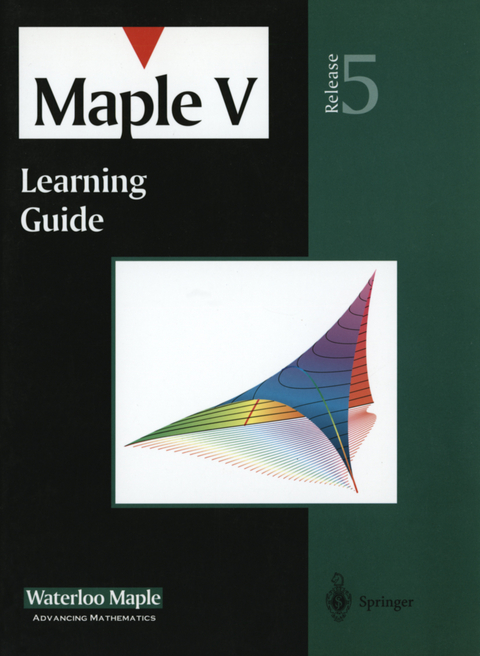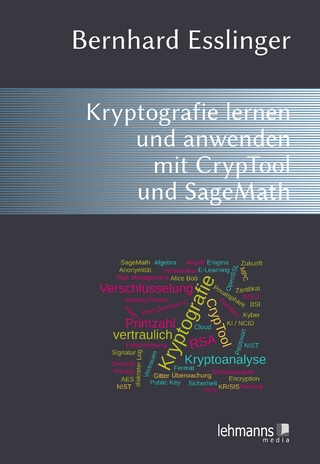
Maple V
Springer-Verlag New York Inc.
978-0-387-98397-4 (ISBN)
Maple V Mathematics Learning Guide is the fully revised introductory documentation for Maple V Release 5. It shows how to use Maple V as a calculator with instant access to hundreds of high-level math routines and as a programming language for more demanding or specialized tasks. Topics include the basic data types and statements in the Maple V language. The book serves as a tutorial introduction and explains the difference between numeric computation and symbolic computation, illustrating how both are used in Maple V Release 5. Extensive "how-to" examples are presented throughout the text to show how common types of calculations can be easily expressed in Maple. Graphics examples are used to illustrate the way in which 2D and 3D graphics can aid in understanding the behaviour of problems.
1. Interactive Use of Maple.- 1.1 The Worksheet Interface.- 1.2 Tutorial 1: Solving Problems.- 1.4 Tutorial 3: Documenting Your Work.- 1.5 Tutorial 4: Multiple Worksheets.- 1.6 Tutorial 5: Getting Help.- 1.7 Conclusion.- 2. Mathematics with Maple: the Basics.- 2.1 Introduction.- 2.2 Numerical Computations.- 2.3 Basic Symbolic Computations.- 2.4 Assigning Names to Expressions.- 2.5 More Basic Types of Maple Objects.- 2.6 Expression Manipulation.- 2.7 Conclusion.- 3. Finding Solutions.- 3.1 Simple solve.- 3.2 Solving Numerically: fsolve.- 3.3 Other Solvers.- 3.4 Polynomials.- 3.5 Calculus.- 3.6 Differential Equations: dsolve.- 3.7 The Organization of Maple.- 3.8 The Maple Packages.- 3.9 Conclusion.- 4. Graphics.- 4.1 Graphing in Two Dimensions.- 4.2 Graphing in Three Dimensions.- 4.3 Animation.- 4.4 Annotating Plots.- 4.5 Composite Plots.- 4.6 Special Types of Plots.- 4.7 Manipulating Graphical Objects.- 4.8 Conclusion.- 5. Evaluation and Simplification.- 5.1 Mathematical Manipulations.- 5.2 The Assume Facility.- 5.3 Structural Manipulations.- 5.4 Evaluation Rules.- 5.5 Conclusion.- 6. Examples from Calculus.- 6.1 Introductory Calculus.- 6.2 Ordinary Differential Equations.- 6.3 Partial Differential Equations.- 6.4 Conclusion.- 7. Input and Output.- 7.1 Reading Files.- 7.2 Writing Data to a File.- 7.3 Exporting Whole Worksheets.- 7.4 Printing Graphics.- 7.5 Conclusion.
| Mitarbeit |
Assistent: K.M. Heal, M.L. Hansen, K.M. Rickard, J.S. Devitt |
|---|---|
| Zusatzinfo | 8 Illustrations, color; 85 Illustrations, black and white; IX, 284 p. 93 illus., 8 illus. in color. |
| Verlagsort | New York, NY |
| Sprache | englisch |
| Maße | 170 x 244 mm |
| Themenwelt | Mathematik / Informatik ► Informatik ► Programmiersprachen / -werkzeuge |
| Informatik ► Theorie / Studium ► Algorithmen | |
| Mathematik / Informatik ► Mathematik ► Analysis | |
| Mathematik / Informatik ► Mathematik ► Angewandte Mathematik | |
| Mathematik / Informatik ► Mathematik ► Wahrscheinlichkeit / Kombinatorik | |
| ISBN-10 | 0-387-98397-X / 038798397X |
| ISBN-13 | 978-0-387-98397-4 / 9780387983974 |
| Zustand | Neuware |
| Informationen gemäß Produktsicherheitsverordnung (GPSR) | |
| Haben Sie eine Frage zum Produkt? |
aus dem Bereich


